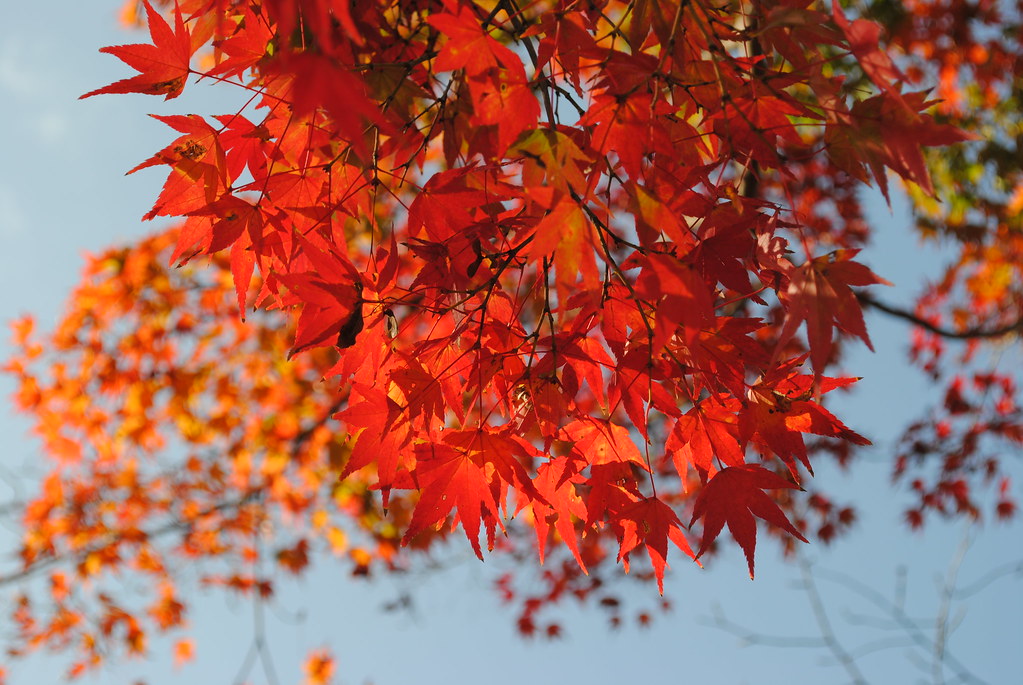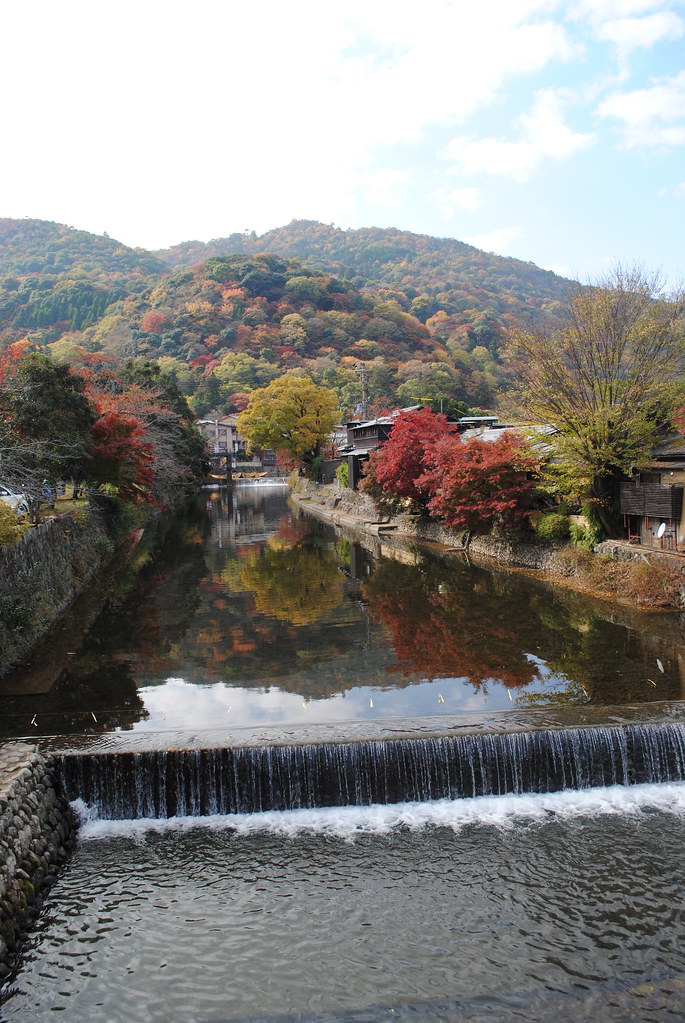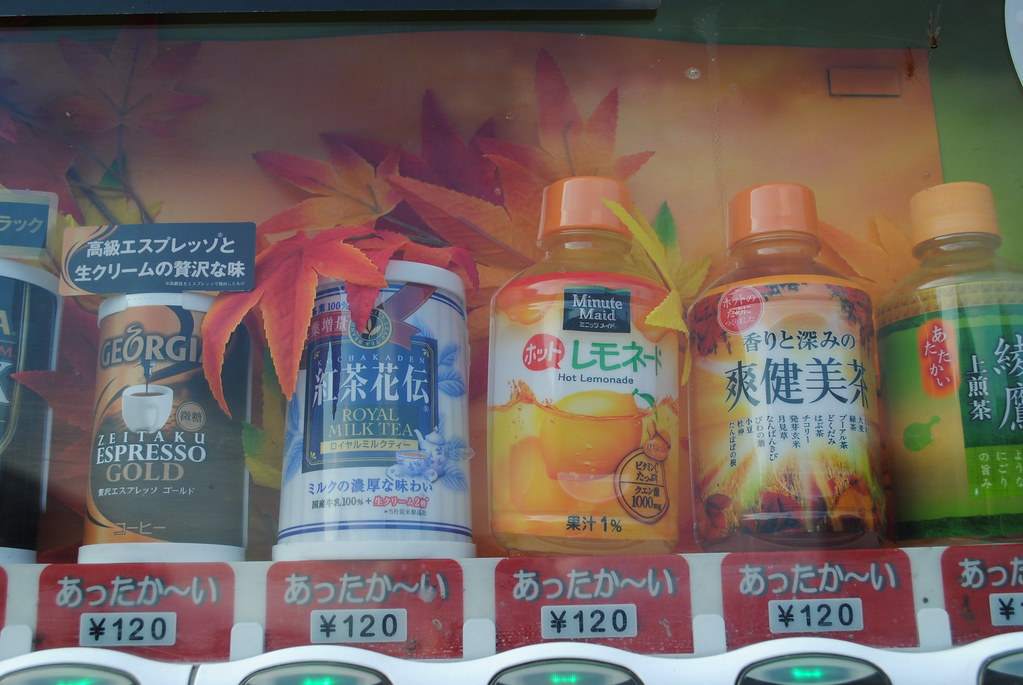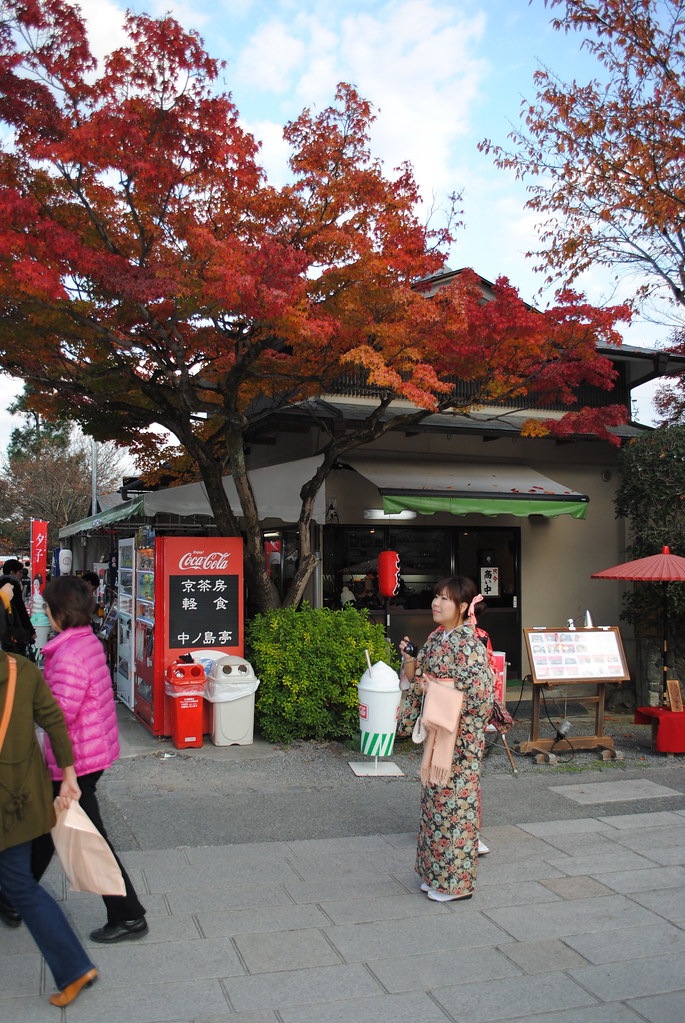秋 (あき - aki - Autumn) is widely considered the best season of the year in Japan, sharing a very comfortable temperature range with 春 (はる - haru - Spring). While 春 is associated with the excitement of new beginnings, in some ways 秋 is much more subdued; it's a time to relax, reflect and enjoy the weather as it cools the scorching highs of 夏 (なつ - natsu - Summer). Having said that, 紅葉狩り (もみじがり - momijigari - Autumn leaf viewing, literally "maple hunting") is as big a deal as 花見 (はなみ - hanami - cherry blossom viewing) and when you start seeing whole hillsides turning blazing red, I'm sure you'll understand why.
The star player of 紅葉狩り is the 紅葉 (もみじ - momiji - Japanese maple, literally "crimson leaves"). Depending on the particular tree, the colours may actually range from bright orange to very dark red, but the effect is striking regardless; the reds mix with the yellows of other trees and set the countryside on fire throughout the second half of November. For this reason, 秋 is considered a great time to get out of the house and go sightseeing, or to be active outdoors; this is why 体育祭 (たいいくさい - taiikusai - sports festivals) always happen at this time of year. Herein lies the contradiction of 秋 - as I said earlier, it's associated with both sport and culture, a time to go out and be active as well as relaxing and meditating indoors. It's hard to say why, beyond the fact that the weather is very conducive to both.
秋 is harvest time, meaning that it's a time of productivity and good business (particularly for the shops in tourist areas!), a very pretty period of change before the cold arrives. 神社 (じんじゃ - jinja - Shinto shrines) are popular in their role as worshippers of the natural world, with people coming to give thanks in their local communities throughout their 秋 travels. 嵐山 (あらしやま - Arashiyama, literally the provocative "storm mountain") is a particularly busy destination, sitting in the outskirts of 京都 (きょうと - Kyoto). As recently as the thirteenth and fourteenth century, it was treated as a dumping ground for corpses that weren't burned or buried and generally considered best avoided. Several 神社 and お寺 (おてら - otera - temples) were set up there by 侍 (さむらい - samurai) and their families, who became priests to atone for the sins of their lives. Many of these 神社 and お寺 now form part of a bustling tourism precinct - it's now much more a gorgeous 紅葉狩り spot than a haunting ground.
While places like 嵐山 have a mixture of 秋 colours, several spots like 箕面公園 (みのおこうえん - minou kouen - Minoo Park) in 大阪 (おおさか - Osaka) are made up exclusively of 紅葉 trees that set the entire mountain blushing red. Whether you're planning a day of 紅葉狩り at 箕面 or elsewhere, however, you'd best start early. The days during 秋 start getting very short - in fact, they're the subject of several proverbs - "秋の陽は釣瓶落とし" (あきのひはつるべおとし - aki no hi wa tsurube otoshi), for example. 釣瓶 (つるべ - tsurube) refers to a bucket used to draw water out of a well, so the sentence can be roughly translated to "the Autumn sun plunges into the well". Sure enough, it's bright one second during the evening here and pitch dark within a few minutes, so I can see where the imagery comes from. This is perhaps the reason for another proverb - "読書の秋" (どくしょのあき - dokusho no aki), meaning "Autumn reading" - once you're finished your day of sport and frenzied activity, the early nightfall means you'll have plenty of time before bed to catch up on some reading and culture inside where it's warm; that might be another reason for the dual-purpose nature of 秋.
紅葉狩り is not as regimented as 花見, if you take the latter as planned-out time spent with coworkers, picnic lunches and good 酒 (さけ - sake). Most people are just as happy to spontaneously find a good spot under a tree and enjoy a 弁当 (べんとう - bento) during 紅葉狩り; others will just seek out a good restaurant and enjoy some of the local fare with friends or family. The foods most commonly associated with 秋 are things like 栗 (くり - kuri - chestnuts) and an extraordinarily expensive mushroom called 松茸 (まつたけ - matsutake). Apart from that, the ubiquitous festival food stalls spring up at all the popular spots selling favourites like お好み焼き (おこのみやき - okonomiyaki), buttered corn, フランクフルト (frankfurts) and more recently, 肉おにぎり (niku onigiri - rice balls wrapped with thinly sliced pieces of meat).
Perhaps one of the reasons for the food culture during 秋 lies in another piece of history. With its abundance of post-harvest food, 侍 considered it the ideal season to fatten up their horses for the winter; they seemed to have massive appetites at this time of year. People definitely aren't exempt from this, which is probably the source of one final proverb - "食欲の秋" (しょくよくのあき - shokuyoku no aki), meaning "Autumn appetite".
Of course, businesses are only too happy to encourage this - even the 自動販売機 (じどうはんばいき - jidouhanbaiki - vending machines) get into the 秋 spirit and try to tempt you with the fruits of the season. With all the food around and the comfort and contentment 秋 brings, it's very tempting to reach for another 肉おにぎり. Make sure you don't indulge yourself too much, unless you want to be fattened up for the winter as well!
It may not have quite the frantic energy of 春 or the long, relaxing evenings of 夏, but 秋 is a gorgeous season content to rely on its lovely temperate weather and the stunning sights of the 紅葉 to draw the crowds. It's not too sleepy but not too busy, not too hot but not too cold - the Goldilocks of Japan's four seasons has definitely earned its popularity. Whether you're spending the season actively seeing the sights, curling up with a good book at home, sampling some of the local specialties or all of the above, 秋 will be just the ticket. Enjoy it your way!







No comments:
Post a Comment
If you have any questions or additions, I would love to hear from you. I may not know the answer, but I'll do my best to find out in any case! You can post anonymously if you like, but abusive/unintelligible/inappropriate comments will not be published.